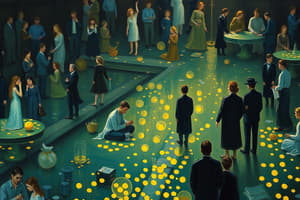Podcast
Questions and Answers
According to social disorganization theory, crime is primarily influenced by which of the following factors?
According to social disorganization theory, crime is primarily influenced by which of the following factors?
- Neighborhood dynamics (correct)
- Family dynamics
- Peer group influences
- Individual actions and behaviors
What key finding supported Shaw and McKay's social disorganization theory?
What key finding supported Shaw and McKay's social disorganization theory?
- Presence of nuclear families in the community
- Strong peer support networks
- High socio-economic status of residents
- High delinquency rates in areas with poor housing and health conditions (correct)
How did Shaw and McKay explain the patterns of delinquency in immigrant-settled areas?
How did Shaw and McKay explain the patterns of delinquency in immigrant-settled areas?
- Due to individual actors' actions
- Related to family dynamics
- As a result of strong social norms
- Because of weakened social controls (correct)
Which theory examines the relationship between the design of physical space and crime?
Which theory examines the relationship between the design of physical space and crime?
What concept does broken windows theory explore in relation to crime?
What concept does broken windows theory explore in relation to crime?
Which factor is NOT identified as a contributor to patterns of delinquency in areas studied by Shaw and McKay?
Which factor is NOT identified as a contributor to patterns of delinquency in areas studied by Shaw and McKay?
What is the central argument of routine activities theory?
What is the central argument of routine activities theory?
According to Robert Merton's strain theory, what causes crime?
According to Robert Merton's strain theory, what causes crime?
According to Jock Young, what factors contribute to crime in contemporary society?
According to Jock Young, what factors contribute to crime in contemporary society?
What is the central idea behind Albert Cohen's concept of status frustration?
What is the central idea behind Albert Cohen's concept of status frustration?
According to Cloward and Ohlin, what factor influences delinquency in different neighborhoods?
According to Cloward and Ohlin, what factor influences delinquency in different neighborhoods?
What is the relationship between anomie/strain theory and subcultural theory?
What is the relationship between anomie/strain theory and subcultural theory?




